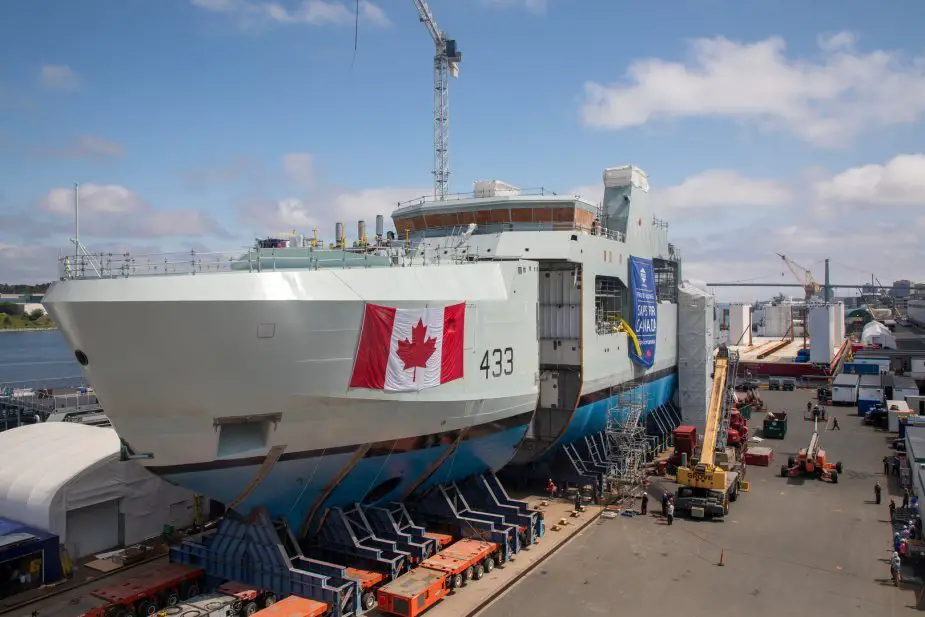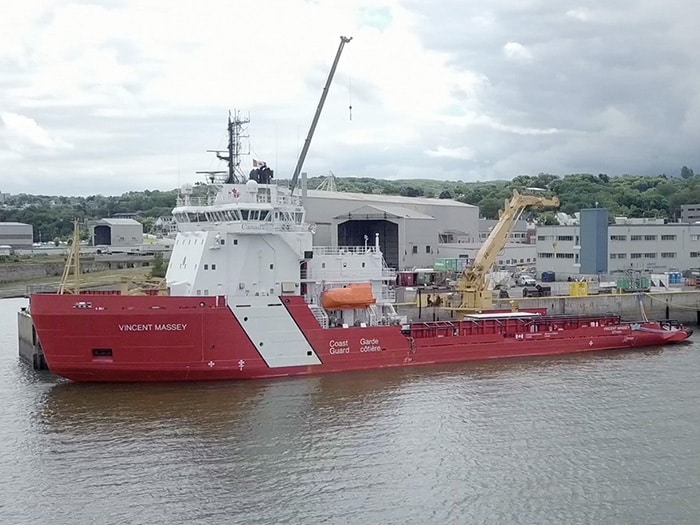And a good description of what we would need to do to spend this windfall:
Royal Canadian Navy Discussions and updates
- Thread starter stephen weist
- Start date
John Fedup
The Bunker Group
Agree, some great and just as important “doable” suggestions that could make things happen in a more timely manner. This is just as important as increased funding. We need both!And a good description of what we would need to do to spend this windfall:
Decent article about two RCN clearance divers currently seconded to the New Zealand Navy.
If she can do it, I can do it
Good to see that they mention that the culture within the Canadian training courses has changed for the better.
If she can do it, I can do it
Good to see that they mention that the culture within the Canadian training courses has changed for the better.
John Fedup
The Bunker Group
The RCN had better be careful, NZ must be looking pretty good with its range of attractions (and warmer waters in some areas).Decent article about two RCN clearance divers currently seconded to the New Zealand Navy.
If she can do it, I can do it
Good to see that they mention that the culture within the Canadian training courses has changed for the better.
Underway
Active Member
Some CSC information from CANSEC 2022 after talking to numerous vendors.
- Safran is providing the New Generation Dagaie System which launches decoys. They are providing one system per ship two launchers total, one port one starboard fitted above the flex deck space on the ASM deck by the looks of things.
They can launch the standard IR and RF decoys (chaff and flare), but can also do an Active Offboard Decoy which is an interesting touch. I expect that that last one creates emissions that simulate a ship and can pull radar homing missiles away. It's also able to deploy Anti Torp decoys but I expect that the torp decoy system will be dedicated (I believe ULTRA electronics is providing that).
The Safran vendor told me however the MDA was dealing with the ammunition that it would use, which the MDA vendor didn't know too much about, but that might have been a language barrier (the Safran vendor was very Parisian and between her accented English and my terrible French there might have been a breakdown).
- Speaking of MDA they are providing quite a bit of stuff. X-band fire control radar, laser warning detector, laser dazzler/defence system (not for people but to counter laser targeting), and the ESM communications suite. I was told that they are also optimizing the antenna for the RAVEN ECM. MDA is also integrating the entire EW suite together, or perhaps they are second fiddle to LMC for that integration work. That was a bit unclear to me.
- IrvinGQ is providing a floating decoy.
- Leonardo is going to provide the MARLIN-WS 30mm as the guns for the quarters above the hangar. I'm guessing that they bid both the 30mm and 127mm together beating out BAE for the package.
What is interesting to me is the three options available either Remote Controlled, Coax Camera, or Independent Line of Sight. If I had to pick an option it would be ILOS. The fact that the gun can take external targeting information from CMS is very interesting. This opens up the potential of the Xband FC radar giving information to the gun which will then automatically swivel and shoot with the appropriate rounds (dual feed so you can select one of two options).
The elevation is -19 to +70 and it has airburst munitions which are the best option vs boat swarms and small UAV's/loitiering munitions
Underway
Active Member

This was released sometime beginning of March by the RCN but everyone seemed to have missed it with the Ukraine War taking our attention. New mast design and more information on the systems and vendors. Note the 8080 tonnes and 151.4 meters. Varies from what we know of HMS Glasgow and HMAS Hunter.
http://www.navy-marine.forces.gc.ca/assets/NAVY_Internet/docs/en/fleet/csc-fact-sheet-eng.pdf
Have I got this wrong or Is it me or has the proposed CAAM VLS aft of the funnel gone missing in this graphic. I was of the understanding the ships would have ESSM, SM2 and CAAM. The number of Mk41 cells also appears to be down on previous graphicsView attachment 49417
This was released sometime beginning of March by the RCN but everyone seemed to have missed it with the Ukraine War taking our attention. New mast design and more information on the systems and vendors. Note the 8080 tonnes and 151.4 meters. Varies from what we know of HMS Glasgow and HMAS Hunter.
http://www.navy-marine.forces.gc.ca/assets/NAVY_Internet/docs/en/fleet/csc-fact-sheet-eng.pdf
Good to see Tomahawk in there.
I could be mistaken and my understanding may be well out of date.
Underway
Active Member
CAAM is listed on the left side "Weapons" heading. Some of those headings don't match particularly well the general area items will be placed on the ship.Have I got this wrong or Is it me or has the proposed CAAM VLS aft of the funnel gone missing in this graphic. I was of the understanding the ships would have ESSM, SM2 and CAAM. The number of Mk41 cells also appears to be down on previous graphics
Good to see Tomahawk in there.
I could be mistaken and my understanding may be well out of date.
Yes the number is down to 24 Mk41 VLS and 6ExLS. As you can see by the tonnage the margins are tight. Here is another graphic I found a few minutes ago with all the various systems labeled (the CAAM is mislabeled but it's there on the ship).

Last edited:
Thanks, my bad, I did not look hard enough. I expect the sensor package (and supporting systems) are eating into the margin compared to the reference design (in the same manner as the Hunter Class).CAAM is listed on the left side "Weapons" heading. Some of those headings don't match particularly well the general area items will be placed on the ship.
Yes the number is down to 24 Mk41 VLS and 6ExLS. As you can see by the tonnage the margins are tight. Here is another graphic I found a few minutes ago with all the various systems labeled (the CAAM is mislabeled but it's there on the ship).
View attachment 49418
Underway
Active Member
There are a number of differences that eat into margins on both the CSC and Hunter class. The UK is putting HMS Glasgow into a carrier task group, and as such it needs to do its specific job of ASW. The Type 45's and QE2 can do the air search and fight the air war. They even have AEW helicopters integral into that TG team.Thanks, my bad, I did not look hard enough. I expect the sensor package (and supporting systems) are eating into the margin compared to the reference design (in the same manner as the Hunter Class).
Canada's fleet mix will be the Joint Support Ship and CSC. Which means that CSC has to fight do both AAW and ASW. This means the RCN needs to pack more "stuff" into the hull as they don't have big AAW destroyers or a fleet air arm to do the air war bit. The other RCN focus was survivability for the ship. I'd argue that was the number one focus. Hence the plethora of decoys and detectors onboard. And two different combat systems (which is weird, I'm not sure how they are going to implement that and it seems high risk).
Underway
Active Member
Some SPY-7 information on page 30 of this 2020 edition of Canadian Naval Review with some SPY-6 comparisons.
https://navalreview.ca/wp-content/uploads/CNR_pdf_full/cnr_vol15_3.pdf
TLDR:
Multiple TRM's (transmitter receiver modules) are in blocks called subarrays. Subarrays are built directly into the backside of the radar array's surface. These subarrays are modular and can be easily removed for repair (30 seconds in some cases).
The SPY-6 sub-arrays are 2'x2'x2' and the SPY-7 subarrays are shoebox-sized (so significantly smaller) and arranged perpendicular to the surface (the small face of the shoebox points outwards).
Adding more subarrays increases the range and sensitivity of the radar (identical to the SPY-6). Both radars can replace a subarray's without shutting down the other ones.
The capability is that CSC will get SPY-1D ranges from a much smaller footprint.
https://navalreview.ca/wp-content/uploads/CNR_pdf_full/cnr_vol15_3.pdf
TLDR:
Multiple TRM's (transmitter receiver modules) are in blocks called subarrays. Subarrays are built directly into the backside of the radar array's surface. These subarrays are modular and can be easily removed for repair (30 seconds in some cases).
The SPY-6 sub-arrays are 2'x2'x2' and the SPY-7 subarrays are shoebox-sized (so significantly smaller) and arranged perpendicular to the surface (the small face of the shoebox points outwards).
Adding more subarrays increases the range and sensitivity of the radar (identical to the SPY-6). Both radars can replace a subarray's without shutting down the other ones.
The capability is that CSC will get SPY-1D ranges from a much smaller footprint.
John Fedup
The Bunker Group
Another delay is announced for JSS. First ship is not due until 2025. The program continues to disappoint.

 www.defensenews.com
www.defensenews.com

Canada’s new fleet of supply ships get hit by another delay
Now, the first joint support ship won’t be delivered until at least 2025, while the second is supposed to arrive in 2027.
Some good news for CSC...
CSC Complete Preliminary design Review - (Linked In Link)
Transcript below for BAE Systems Canada post on Linked In:
" A key milestone in support of Preliminary Design Review (PDR) for the Canadian Surface Combatant was delivered last week.
This event was held at the ISI facility in Halifax, attended by colleagues from across BAE Systems, Lockheed Martin Canada, Irving Shipbuilding and the Canadian Customer Project Management Office (PMO). It demonstrated the culmination of the last seven month’s collective work, where the industry team has been working to integrate the CSC combat system onto the platform.
SSIA #3 shall define the technical baseline to support CSC Functional Design moving forward.
CSC Delivery Director, Colin McMillan, said: “This was a significant and collaborative undertaking across BAE Systems, LM, ISI and the Canadian customer PMO and supports our shared goals on the programme. A huge thanks to everyone involved.” "
CSC Complete Preliminary design Review - (Linked In Link)
Transcript below for BAE Systems Canada post on Linked In:
" A key milestone in support of Preliminary Design Review (PDR) for the Canadian Surface Combatant was delivered last week.
This event was held at the ISI facility in Halifax, attended by colleagues from across BAE Systems, Lockheed Martin Canada, Irving Shipbuilding and the Canadian Customer Project Management Office (PMO). It demonstrated the culmination of the last seven month’s collective work, where the industry team has been working to integrate the CSC combat system onto the platform.
SSIA #3 shall define the technical baseline to support CSC Functional Design moving forward.
CSC Delivery Director, Colin McMillan, said: “This was a significant and collaborative undertaking across BAE Systems, LM, ISI and the Canadian customer PMO and supports our shared goals on the programme. A huge thanks to everyone involved.” "
Sshh, don't discourage our Canuck cuzzies. They need all the encouragement that they can get.That’s not PDR, that’s a lead up review heading towards PDR.
Sandhi Yudha
Well-Known Member
With a displacement of 6615 metric ton, this new patrolboat will have a displacement of a destroyer, but ofcourse the ship is specially made for the arctic environment.
The William Hall will be capable of 17 knots (31 km/h; 20 mph) in open water and 3 knots (5,6 km/h; 3,5 mph) while icebreaking in new year ice of 1-metre (3 ft 3 in) thickness.
The ship will also be equipped with a bow thruster to aid during maneuvers and docking procedures without requiring tugboat assistance. The ship will also have an impressive range of 6800 nautical miles (12.600 km; 7800 mi) and an endurance of 120 days with 65 personnel.

 www.navyrecognition.com
www.navyrecognition.com
The William Hall will be capable of 17 knots (31 km/h; 20 mph) in open water and 3 knots (5,6 km/h; 3,5 mph) while icebreaking in new year ice of 1-metre (3 ft 3 in) thickness.
The ship will also be equipped with a bow thruster to aid during maneuvers and docking procedures without requiring tugboat assistance. The ship will also have an impressive range of 6800 nautical miles (12.600 km; 7800 mi) and an endurance of 120 days with 65 personnel.

Construction of the Harry DeWolf class OPV William Hall in progress
According to information published by Irving Shipbuilding on August 8, 2022, the bow Mega Block has been successfully rolled onto land level to form the fo
Finally, the third "interim" icebreaker for the CCG has been launched:

 www.marinelog.com
www.marinelog.com

VIDEO: Davie delivers third medium icebreaker to Canadian Coast Guard
Helping Maritime Professionals Make Informed Decisions
In fact, it broke ice twice as thick during trials:With a displacement of 6615 metric ton, this new patrolboat will have a displacement of a destroyer, but ofcourse the ship is specially made for the arctic environment.
The William Hall will be capable of 17 knots (31 km/h; 20 mph) in open water and 3 knots (5,6 km/h; 3,5 mph) while icebreaking in new year ice of 1-metre (3 ft 3 in) thickness.
The ship will also be equipped with a bow thruster to aid during maneuvers and docking procedures without requiring tugboat assistance. The ship will also have an impressive range of 6800 nautical miles (12.600 km; 7800 mi) and an endurance of 120 days with 65 personnel.

Construction of the Harry DeWolf class OPV William Hall in progress
According to information published by Irving Shipbuilding on August 8, 2022, the bow Mega Block has been successfully rolled onto land level to form the fowww.navyrecognition.com
Seems like the RCN has gotten itself a pretty good platform. By all accounts, performance in tropical climates was good as well, so it's a great multi-purpose and multi-environment platform.
That's absolutely true, and comes up often in discussions about this class. It is important, however, to remember that this is primarily a surveillance platform, with a secondary constabulary role, and some limited HADR capabilities. This class was not contemplated as a combatant, and is not designed to warship standards. It's main role, when envisaged in the early 2000s, was to perform sovereignty presence patrols in the Arctic, where Canada had a poor concept of what was happening in its own waters. As such, the government fitted this ship with a pretty comprehensive suite of surveillance kit, and a full command management system (CMS330). Some of those capabilities are shown here (scroll to bottom): Arctic and Offshore Patrol Ships. The plethora of antennae on the ship are also indicative of that function. It can also see under the water with TRAPS (Acoustic Systems from Our Canadian Friends). TRAPS was tested last year during a cruise in the Arctic by HMCS Harry Dewolf (New sonar system tested aboard Harry DeWolf - Canada.ca). As a surveillance platform for the harsh Arctic environment, it's proving to be pretty effective. It would not surprise me to learn that the class has some built in "Five Eyes" listening capabilities, given the close proximity to Russia of their patrol areas.Just a pity they don’t have a bit more in self defence capability; decoys and a CIWS of some sort would be good. At the moment it looks like they have capability to detect an inbound missile but not to do anything about it.
Having said all that, I do feel that with the latest adventurism by Russia, and the ever present Chinese threat, some self-defence capabilities should be fitted. As you indicated, a CIWS and decoy system would be a good start. I think I have seen it suggested somewhere (perhaps even in this forum) that these might inherit some systems from the City class when those ships start to be replaced by the CSC in 8-10 years. This timeline would line up pretty closely with the mid-life refit for first-of-class HMCS Harry Dewolf. It has CMS330, so presumably fitting a surplus Phalanx and perhaps even a surplus Bofors 57mm from a decommissioned frigate would be fairly straight forward, from a software systems perspective. I guess only time will tell, but I do feel this class is a good and timely addition to the RCN. And, given it's pretty impressive ice breaking capabilities, the two ships being built for the Coast Guard should also be good additions to that particular fleet.

